Amine
Question 1. Classify the following amines as primary, secondary, or tertiary:
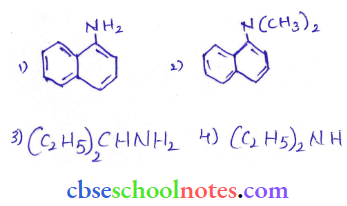
Answer:
- Primary: (1) and (3)
- Secondary: (4)
- Tertiary: (2)
Question 2. Write structures of different isomeric amines corresponding to the molecular formula. C4H11N
- Write the IUPAC names of all the isomers.
- What type of isomerism is exhibited by different pairs of amines?
Answer: (1),(2) The structures and their IUPAC names of different isomeric amines corresponding to the molecular formula. C4H11N are given below:
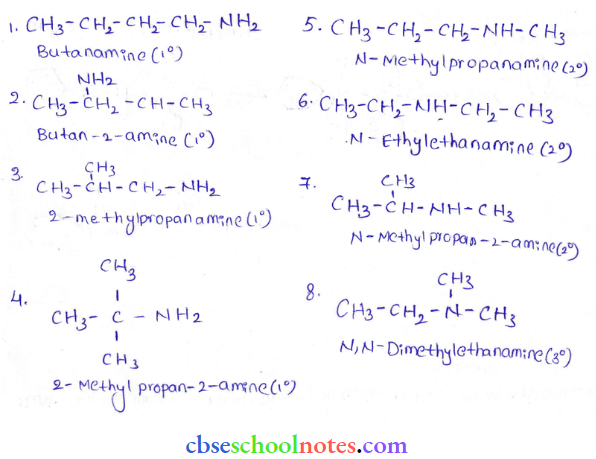
(3) The pairs (1) and (2). (5) and (7) exhibit position isomerism. The pairs (1) and (3); (2) and (d) exhibit chain isomerism. The pairs (5) (6) and (7) exhibit metamerism.
All primary amines exhibit functional isomerism with secondary and tertiary amines and vice-versa.
Read and Learn More Class 12 Chemistry with Answers Chapter Wise
Question 3. How will you convert
- Benzene into aniline
- Benzene into N, N-dimethylaniline
- Cl—(CH2)4-Cl into hexan-1, 6-diamine?
Answer:
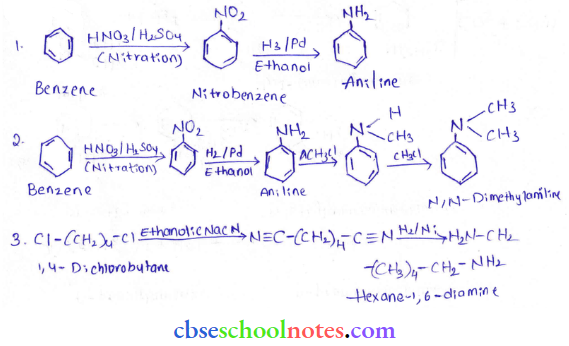
Question 4. Arrange the following in increasing order of their basic strength:
- \(\mathrm{C}_2 \mathrm{H}_5 \mathrm{NH}_2, \mathrm{C}_6 \mathrm{H}_5 \mathrm{NH}_2, \mathrm{C}_6 \mathrm{H}_5 \mathrm{CH}_2 \mathrm{NH}_2 \text { and }\left(\mathrm{C}_2 \mathrm{H}_5\right)_2 \mathrm{NH}\)
- \(\mathrm{C}_2 \mathrm{H}_5 \mathrm{NH}_2 \cdot\left(\mathrm{C}_2 \mathrm{H}_5\right)_2 \mathrm{NH},\left(\mathrm{C}_2 \mathrm{H}_5\right)_3 \mathrm{~N}, \mathrm{C}_6 \mathrm{H}_5 \mathrm{NH}_2\)
- \(\mathrm{CH}_3 \mathrm{NH}_2,\left(\mathrm{CH}_3\right)_2 \mathrm{NH},\left(\mathrm{CH}_3\right)_3 \mathrm{~N}, \mathrm{C}_6 \mathrm{H}_5 \mathrm{NH}_2 \cdot \mathrm{C}_6 \mathrm{H}_5 \mathrm{CH}_2 \mathrm{NH}_2\)
Answer:
- \(\mathrm{C}_6 \mathrm{H}_5 \mathrm{NH}_2<\mathrm{C}_6 \mathrm{H}_5 \mathrm{CH}_2 \mathrm{NH}_2<\mathrm{C}_2 \mathrm{H}_5 \mathrm{NH}_2<\left(\mathrm{C}_2 \mathrm{H}_5\right)_2 \mathrm{NH}\)
- \(\mathrm{C}_6 \mathrm{H}_5 \mathrm{NH}_2<\mathrm{C}_2 \mathrm{H}_5 \mathrm{NH}_2<\left(\mathrm{C}_2 \mathrm{H}_5\right)_3 \mathrm{~N}<\left(\mathrm{C}_2 \mathrm{H}_5\right)_2 \mathrm{NH}\)
- \(\mathrm{C}_6 \mathrm{H}_5 \mathrm{NH}_2<\mathrm{C}_6 \mathrm{H}_5 \mathrm{CH}_2 \mathrm{NH}_2<\left(\mathrm{CH}_3\right)_3 \mathrm{~N}<\mathrm{CH}_3 \mathrm{NH}_2<\left(\mathrm{CH}_3\right)_2 \mathrm{NH}\)
Question 5. Complete the following acid-base reactions and name the products:
- \(\mathrm{CH}_3 \mathrm{CH}_2 \mathrm{CH}_2 \mathrm{NH}_2+\mathrm{HCl} \longrightarrow\)
- \(\left(\mathrm{C}_2 \mathrm{H}_5\right)_3 \mathrm{~N}+\mathrm{HCl} \longrightarrow\)
Answer:
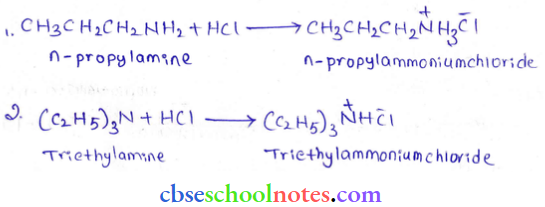
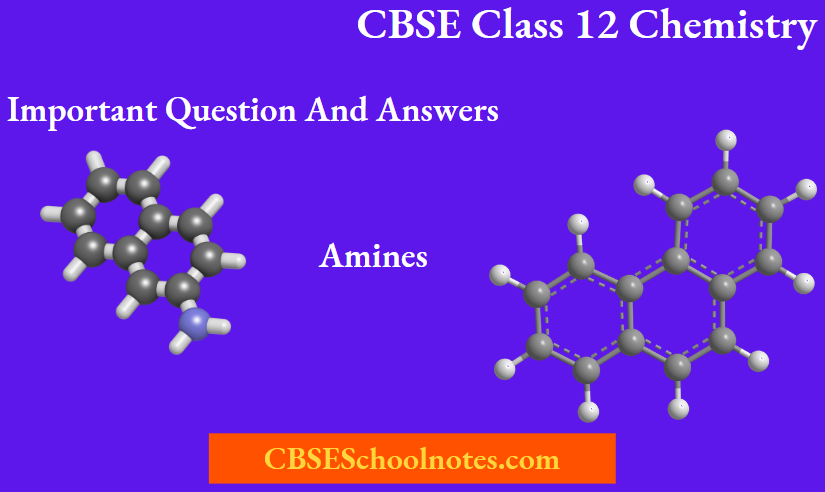
Question 6. Write reactions of the final alkylation product of aniline with excess methyl iodide in the presence of sodium carbonate solution.
Answer: Aniline reacts with methyl iodide to produce N. N-dimethylaniline.
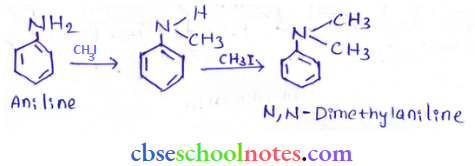
With excess methyl iodide, in the presence of Na2CO3 solution. N, N-dimethylaniline produces N, N, N-trimethylanilinum carbonate.

Question 7. Write the chemical reaction of aniline with benzyl chloride and write the name of the product obtained.
Answer:

Question 8. Write the structure of different isomers corresponding to the molecular formula, C3H9N. Write IUPAC names of the isomers that will liberate nitrogen gas on treatment with nitrous acid.
Answer:
The structure of different isomers corresponding to the molecular formula, C3H9N are given below:
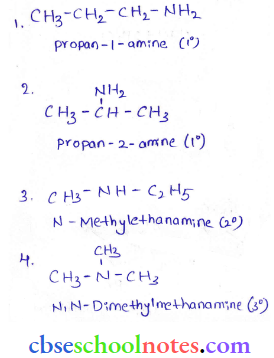
1 amine i.e., (1) propan-1-amine, (2) Propan-2-amine will liberate nitrogen gas on treatment with nitrous acid.
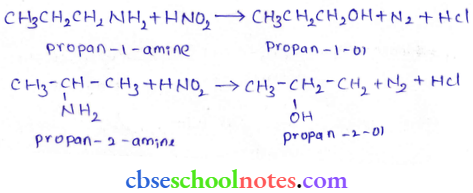
Question 9. Convert
- 3-Methylaniline into 3-nitrotoluene.
- Aniline into 1,3,5-tribromobenzene
Answer:
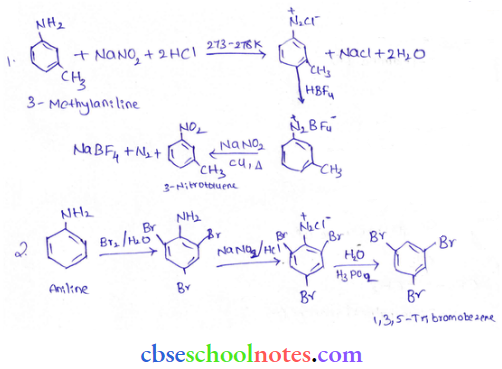
Question 10. Write chemical equations for the following reactions:
- Reaction ofelhanolie NH3 with C2H5CI.
- Ammonolysis of benzyl chloride and the reaction of amine so formed with two moles of CH3CI.
Answer:

Question 11. Write chemical equations for the following conversions:
- \(\mathrm{CH}_3 \cdot \mathrm{CH}_2 \cdot \mathrm{Cl} \text { into } \mathrm{CH}_3 \cdot \mathrm{CH}_2 \cdot \mathrm{CH}_2 \cdot \mathrm{NH}_2\)
- \(\mathrm{C}_6 \mathrm{H}_5 \cdot \mathrm{CH}_2 \cdot \mathrm{Cl} \text { into } \mathrm{C}_6 \mathrm{H}_5 \cdot \mathrm{CH}_2 \cdot \mathrm{CH}_2 \cdot \mathrm{NH}_2\)
Answer:
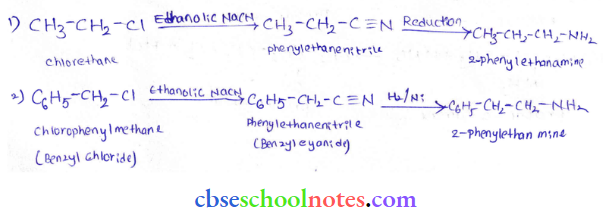
Question 12. Write structures and IUPAC names of
- The amide gives propanamide by Hoffmann bromamide reaction.
- The amine produced by the Hoffmann degradation of ben/amide.
Answer:
Propanamine contains three carbons. Hence, the amide molecule must contain four carbon atoms. The structure and IUPAC name of the starling amide with four carbon atoms are given below:

Benzamide is an aromatic amide containing seven carbon atoms. Hence, the amine formed from benzamide is an aromatic primary amine-containing six carbon atoms.

Question 13. Arrange the following mg in decreasing order of their basic strength:
⇒ \(\mathrm{C}_6 \mathrm{H}_5 \mathrm{NH}_2 \cdot \mathrm{C}_2 \mathrm{H}_5 \mathrm{NH}_2 \cdot\left(\mathrm{C}_2 \mathrm{H}_5\right)_2 \mathrm{NH} . \mathrm{NH}_3\)
Answer: The decreasing order of basic strength of the above amines and ammonia follows the following order:
⇒ \(\left(\mathrm{C}_2 \mathrm{H}_5\right)_2 \mathrm{NH}>\mathrm{C}_2 \mathrm{H}_5 \mathrm{NH}_2>\mathrm{NH}_3>\mathrm{C}_6 \mathrm{H}_5 \mathrm{NH}_2\)
Question 14. How will you convert 4-nitrotoluene to 2-bromobenzoic acid?

Question 15. Write the IUPAC names of the following compounds and classify them into primary, secondary, and tertiary amines.
- \(\left(\mathrm{CH}_3\right)_2 \mathrm{CH} \mathrm{N} \mathrm{H}_2\)
- \(\mathrm{CH}_3\left(\mathrm{CH}_2\right)_2 \mathrm{NH}_2\)
- \(\mathrm{CH}_3 \mathrm{NHCH}\left(\mathrm{CH}_3\right)_2\)
- \(\left(\mathrm{CH}_3\right)_3 \mathrm{C} \mathrm{NH}_2\)
- \(\mathrm{C}_6 \mathrm{H}_5 \mathrm{NHCH}_3\)
- \(\left(\mathrm{CH}_3 \mathrm{CH}_2\right)_2 \mathrm{NCH}_3\)
- \(\mathrm{m}-\mathrm{BrCC}_6 \mathrm{H}_4 \mathrm{NH}_2\)
Answer:
- Propan – 2 – amine (p)
- Propan – I – amine(p)
- N – methyl – 2 – propanamide (s)
- 2 – methyl propane – 2 – amine (p)
- N – methyl aniline (s)
- N – ethyl – N – methyl ethanolamine (t)
- 3 – Bromo benzydamine or 3 – Bromoaniline (p)
Question 16. Give one chemical test to distinguish between the following pairs of compounds.
- Methylamine and dimethylamine
- Secondary and tertiary amines
- Ethylamine and aniline
- Aniline and benzylamine
- Aniline and N – methylaniline
Answer: Methylamine gives an arylamine reaction on heating with CHCl3 and alcoholic KOH. Gives foul smelling (Carbyl amine)
![]()
whereas Dimethylamine does not give this reaction.
Secondary amines were given Kinsberg’s test. It gives insoluble substance with Ginsberg’s reagent (C6H5SO2Cl) which is not affected by base.
![]()
- Whereas tertiary amine does not react with Hinsberg’s reagent.
- Aniline gives azo dye test : Dissolve Aniline in cone. HCl and add ice – a cold solution of HNO2 (NaNO2 + dil HCl) at 273 K and then treat it with an alkaline solution of 2-naphthol. The appearance of brilliant orange or red dye indicates aromatic amine (ie Aniline).
- Whereas aliphatic amine (ie ethylamine) does not form a dye. It will give brisk effervescence due to the evolution of N2 but the solution remains clear.
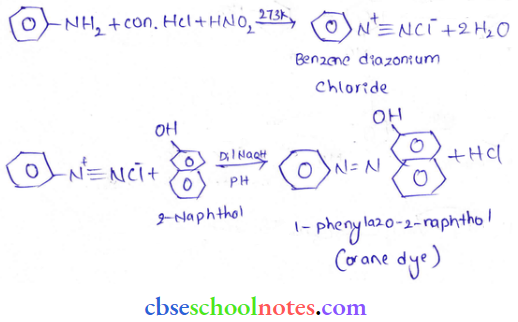
Nitrous acid test: Benzvlainine reacts with nitrous acid (HNO2) to form a diazonium salt which being unstable even at low temperatures, decomposes with the evolution of N2 gas.

Aniline reacts with HNO2 to form benzene diazonium chloride which is stable at 273-278 K and hence does not decompose to evolve N2 gas.

Carbylamine test: Aniline being a primary amine gives a carbylamine test. i.e. when heated with an alcoholic solution of KOH and CHCl3. it gives an offensive smell of phenyl isocyanide. In contrast, N-methyl aniline. being secondary amine does not give this test.

Question 17. Account for the following:
- pKb of aniline is more than that of methylamine.
- Ethylamine is soluble in water whereas aniline is not.
- Methylamine in water reacts with ferric chloride to precipitate hydrated ferric oxide.
- Although the amino group is o- and p-directing in aromatic electrophilic substitution reactions, aniline on nitration gives a substantial amount of m-nitroaniline.
- Aniline does not undergo Friedel-Crafts reaction.
- Diazonium salts of aromatic amines are more stable than those of aliphatic amines.
- Gabrial phthalimide synthesis is preferred for synthesizing primary amines,
Answer:
1. In aniline, the lone pair of electrons on the N-atom are delocalized over the benzene ring. Resulting, the electron density of the nitrogen decreases. On the other hand, in CH3NH2 +1 effect of CH3 increases the electron density of the N-atom. Thus, aniline is a weaker base than methylamine and hence its pKb value is higher than that of methylamine.
2. Ethylamine dissolves in water because it forms hydrogen bonds with water molecules. In aniline due to the large, hydrocarbon part, the extent of H-bonding decreases considerably, and hence aniline is insoluble in water.
3. Methylaminc being more basic than water, accepts a proton from water liberating OH– ions.
![]()
These OHQ ions combine with Fe3+ ions present in H2O to form a brown precipitate of hydrated ferric oxide.
⇒ \(\mathrm{FeCl}_3 \longrightarrow \mathrm{Fe}^{+3}+3 \mathrm{Cl}^{-}\)
![]()
4. Nitration is usually carried out with a mixture of cones. HNO3, and cone. H2SO4. In the presence of these acids, most of the aniline gets protonated to form anilingus ion. Thus in the presence of acids, the reaction mixture consists of aniline and anilinium ion. Now -NH2 groups in aniline are o, p-directing, and activating while the NH+3 group in anilinium ion is m-directing.
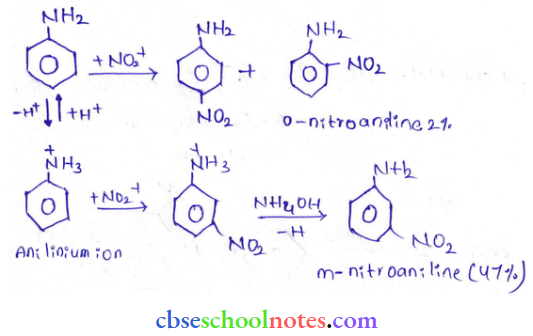
5. Aniline being a Lewis base, reacts with Lewis acid AlCl3 to form a salt.
![]()
As a result, N of aniline acquires a positive charge and hence it acts as a strong deactivating group for electrophilic substitution reaction, consequently, aniline does not undergo Friedel – Crafts reaction.
6. The diazonium salts of aromatic amines are more stable than those of aliphatic amines due to the dispersal of the positive charge on the benzene ring as shown below.

7. Gabriel’s phthalimide reaction gives pure primary amines without any contamination of secondary and tertiary amines. Therefore It is preferred for synthesising (aliphatic) primary amines.
Question 18. Arrange the following:
1. In decreasing order of the pKi, values :
⇒ \(\mathrm{C}_2 \mathrm{H}_5 \mathrm{NH}_2, \mathrm{C}_6 \mathrm{H}_5 \mathrm{NHCH}_3,\left(\mathrm{C}_2 \mathrm{H}_5\right)_2 \mathrm{NH} \text { and } \mathrm{C}_6 \mathrm{H}_5 \mathrm{NH}_2\)
2. In increasing order of basic strength:
⇒ \(\mathrm{C}_6 \mathrm{H}_5 \mathrm{NH}_2 \cdot \mathrm{C}_6 \mathrm{H}_5 \mathrm{~N}\left(\mathrm{CH}_3\right)_2 \cdot\left(\mathrm{C}_2 \mathrm{H}_5\right)_2 \mathrm{NH} \text { and } \mathrm{CH}_3 \mathrm{NH}_2\)
3. In increasing order of basic strength:
- Aniline, p-nitroaniline and p-toluidinc
- \(\mathrm{C}_6 \mathrm{H}_5 \mathrm{NH}_2, \mathrm{C}_6 \mathrm{H}_5 \mathrm{NHCH}_3, \mathrm{C}_6 \mathrm{H}_5 \mathrm{CH}_2 \mathrm{NH}_2\)
4. In decreasing order of basic strength in the gas phase:
⇒ \(\mathrm{C}_2 \mathrm{H}_5 \mathrm{NH}_2 .\left(\mathrm{C}_2 \mathrm{H}_5\right)_2 \mathrm{NH} .\left(\mathrm{C}_2 \mathrm{H}_5\right)_3 \mathrm{~N} \text { and } \mathrm{NH}_3\)
5. In increasing order of boiling point:
⇒ \(\mathrm{C}_2 \mathrm{H}_5 \mathrm{OH} .\left(\mathrm{CH}_3\right)_2 \mathrm{NH} . \mathrm{C}_2 \mathrm{H}_5 \mathrm{NH}_2\)
6. In increasing order of solubilit> in water:
⇒ \(\mathrm{C}_6 \mathrm{H}_5 \mathrm{NH}_2 \cdot\left(\mathrm{C}_2 \mathrm{H}_5\right)_2 \mathrm{NH} . \mathrm{C}_2 \mathrm{H}_5 \mathrm{NH}_2\)
Answer:
- \(\mathrm{C}_6 \mathrm{H}_5 \mathrm{NH}_2>\mathrm{C}_6 \mathrm{H}_5 \mathrm{NH}-\mathrm{CH}_3>\mathrm{C}_2 \mathrm{H}_5 \mathrm{NH}_2>\left(\mathrm{C}_2 \mathrm{H}_5\right)_2 \mathrm{NH}\)
- \(\mathrm{C}_6 \mathrm{H}_5 \mathrm{NH}_2<\mathrm{C}_6 \mathrm{H}_5 \mathrm{~N}\left(\mathrm{CH}_3\right)_2<\mathrm{CH}_3 \mathrm{NH}_2<\left(\mathrm{C}_2 \mathrm{H}_5\right)_2 \mathrm{NH}\)
- \(p \text {-nitroaniline }<\text { aniline }<p \text { – toluidine }\)
- \(\mathrm{C}_6 \mathrm{H}_5 \mathrm{NH}_2<\mathrm{C}_6 \mathrm{H}_5 \mathrm{NHCH}_3<\mathrm{C}_6 \mathrm{H}_5 \mathrm{CH}_2 \mathrm{NH}_2\)
- \(\left(\mathrm{C}_2 \mathrm{H}_5\right)_3 \mathrm{~N}>\left(\mathrm{C}_2 \mathrm{H}_5\right)_2 \mathrm{NH}>\mathrm{C}_2 \mathrm{H}_5 \mathrm{NH}_2>\mathrm{NH}_3\)
- \(\left(\mathrm{CH}_3\right)_2 \mathrm{NH}<\mathrm{C}_2 \mathrm{H}_5 \mathrm{NH}_2<\mathrm{C}_2 \mathrm{H}_5 \mathrm{OH}\)
- \(\mathrm{C}_6 \mathrm{H}_5 \mathrm{NH}_2<\left(\mathrm{C}_2 \mathrm{H}_5\right)_2 \mathrm{NH}<\mathrm{C}_2 \mathrm{H}_5 \mathrm{NH}_2\)
Question 19. How will you convert:
- Ethanoic acid into methenamine
- Hexamentirile into 1-aminopentane
- Methanol to ethanoic acid
- Ethanamine into methamine
- Ethanoic acid into propionic acid
- Methenamine into ethanolamine
- Nitromethane into dimethylamine
- Propanic acid into ethanoic acid
Answer:

Question 20. Describe a method for the identification of primary, secondary, and tertiary amines. Also, write chemical equations of the reactions involved.
Answer:
Benzene sulphonyl chloride (C6H5SO2Cl), Which is also known as llinsberg’s reagent, reacts with primary and secondary amine to form sulphonamide.

The hydrogen attached to nitrogen in sulphone amide is strongly acidic due to the presence of a strong electron-withdrawing sulphonyl group. Hence it is soluble in alkali.

Tertiary amines do not react with benzene sulphonyl chloride.
This property of amines reacting with benzene sulphonyl chloride differently is used for the distinction of primary, secondary, and tertiary amines.
Question 21. Write short notes on the following:
- Carbylamine reaction
- Diazotisation
- Hafmann’s bromamide reaction
- Coupling reaction
- Ammonolysis
- Acetylation
- Gabriel phthalimide synthesis
Answer:
Carbylamine Reaction: Aliphatic and aromatic primary amines on heating with chloroform and ethanolic potassium hydroxide form isocyanide or carbylamines which are foul-smelling substances. Secondary and tertiary amines do not show this reaction, this reaction is known as the carby lamine reaction or idiocy and test and is used as a least for primary amine.
![]()
Diazotization reaction: When a cold solution of a primary aromatic amine in a dilute mineral acid (MCI or IfS()4) is treated with a cold solution of nitrous acid at 273 – 278 K. arene diazonium salt is formed. This reaction is called the diazotization reaction.
For example: \(\mathrm{NaNO}_2+\mathrm{HCl} \longrightarrow \mathrm{HNO}_2+\mathrm{NaCl}\)

Hoffmann’s Bromamide Reactions: The conversions of a primary amide to a primary amine-containing one carbon atom less than the original amide on heating with a mixture of Br2 in the presence of NaOH or KOH is called Haffmann’s bromamide reaction, for example.

This reaction is extremely useful for converting a higher homolog to the next lower ho mo log lie.
Coupling Reaction: The reaction of diazonium salts with phenols and aromatic amines to form a/o compounds of the general formula Ar — N = N — Ar is called a coupling reaction. In this reaction, the nitrogen atoms of the diazo group are retained in the product. The coupling with phenols takes place in a mildly alkaline medium while with amines it occurs under faintly acidic conditions.
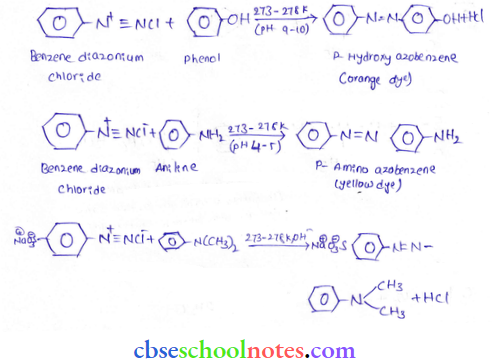
Animonolysis: The process of cleavage of the C – X bond by ammonia molecule is known as ammonolysis.

Acetylation: The process of introducing an acetyl group into a molecule is called acetylation. Common acetylating agents used arc acetyl chloride and acetic anhydride.
into a molecule is called acetylation. Common acetylating agents used arc acetyl chloride and acetic anhydride.

Gabriel Phthalimide Synthesis: In this reaction, phthalimide is converted into its potassium salt by treating it with alcoholic potassium hydroxide. Then potassium phthalimide is heated with an alkyl halide to yield an N alkylphthalimide which is hydrolyzed to phthalic acid and primary amine by heating with HCl or KOH solution.
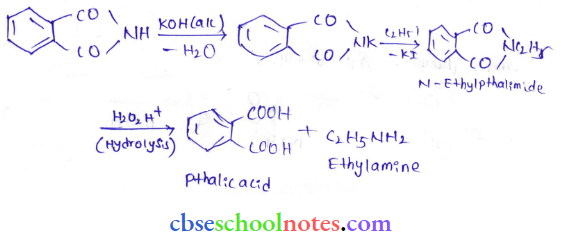
aromatic primary amines cannot be prepared by this method.
Question 22. Accomplish the following conversions:
- Nirobenzene to benzoic acid
- Benzene to m-bromophenol
- Benzoic acid to aniline
- Aniline to 2.4.6-tribromolluorobenxcne
- Benzyl chloride to 2-phenylethanolamine
- Chlorobenzene to p-chloroaniJine
- Aniline to p-bromoaniline
- Benzamide to toluene
- Aniline to benzyl alcohol
Answer:
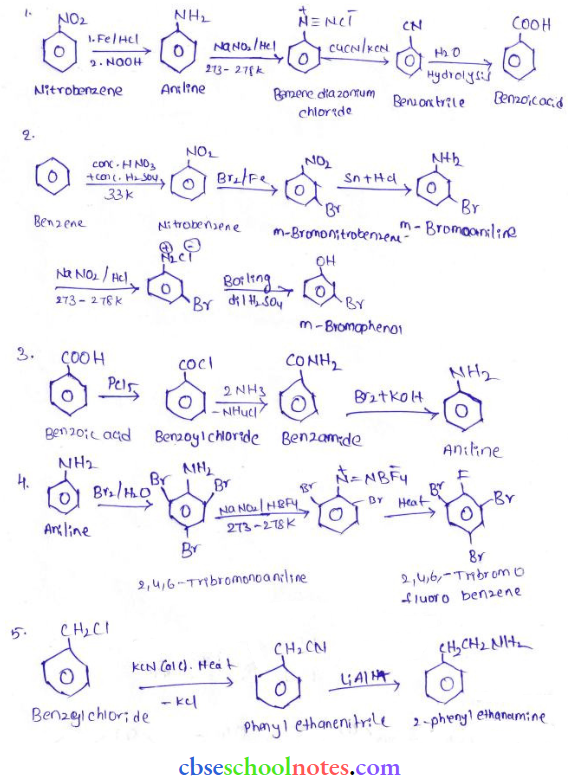

Question 23. Give the structure of A, B, and C in the following reaction:
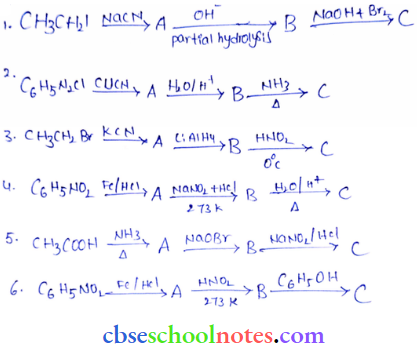
Answer:
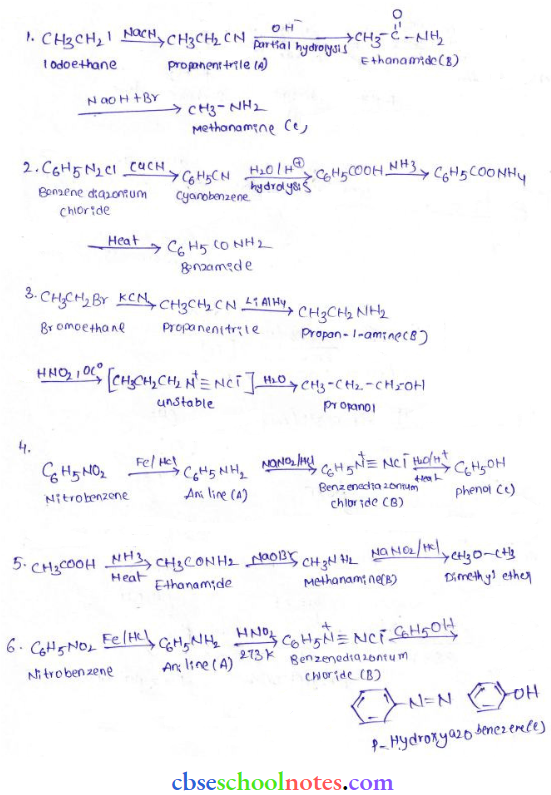
Question 24. An aromatic compound ‘A’ on treatment with aqueous ammonia and heating forms compound ‘B’ which on heating with Br2 and KOH forms a compound C of molecular formula C6H7N. Write the structures and IUPAC names of compounds A, B, and C.
Answer:

Question 25. Complete the following reactions:

Answer:
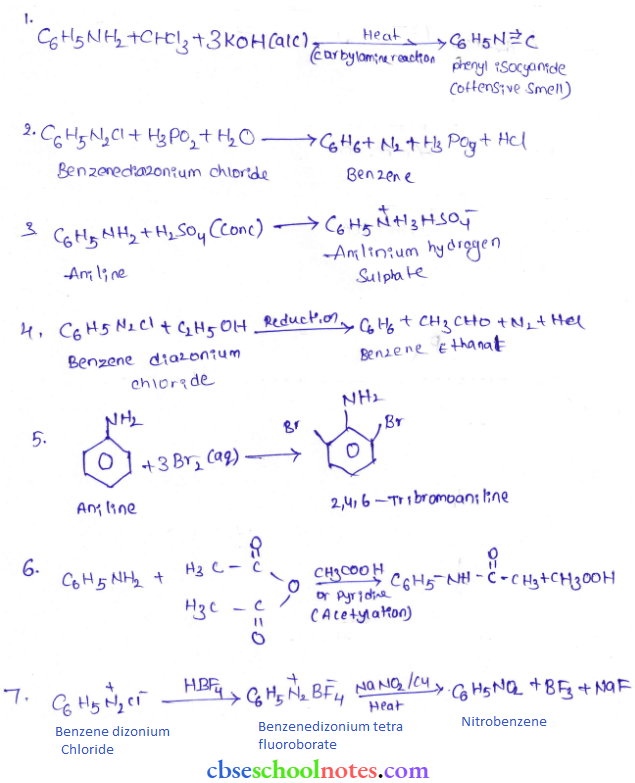
Question 26. Win aromatic primary amines can not be prepared by Gabriel phthalimide synthesis.
Answer:
The success of Gabriel’s phthalimide reaction depends upon the nucleophilic attack by the phthalimide anion on the organic halogen compound.
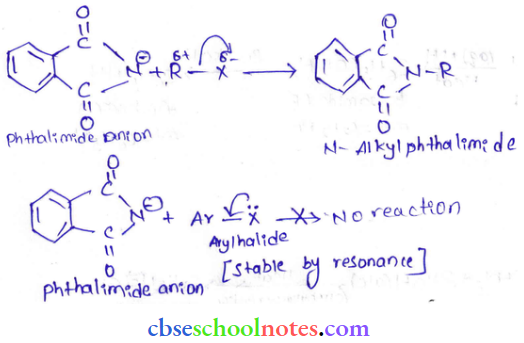
As aryl halides do not undergo nucleophilic substitution reaction easily, aromatic primary amines cannot be prepared by Gabriel phthalimide reaction.
Question 27. Write the reactions of (1) aromatic and (2) aliphatic primary amines with nitrous acid.
Answer:
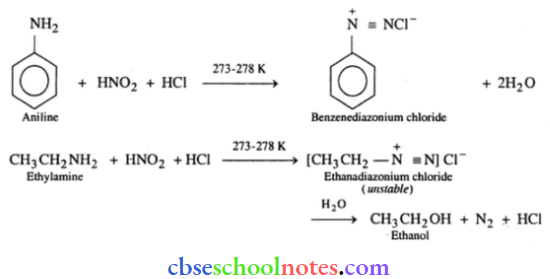
Question 28. Give a plausible explanation for each of the following:
- Why are amines less acidic than alcohols of comparable molecular masses?
- Why do primary amines have a higher boiling point than tertiary amines?
- Why do aliphatic amines arc stronger bases than aromatic amines?
Answer:
Loss of a proton from an amine gives an amide ion (N–H) while loss of a proton from alcohol gives an alkoxide ion (O–R) as shown below.
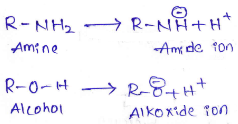
As O is more electronegative than N, So negative charge on a more electronegative atom is more stable. As R—O is more stable than RNH–. Therefore amines are less acidic than alcohols.
Due to the presence of two H-atoms on N-atoms of 1° amines, they undergo extensive intermolecular H-bonding while at 3° amines due to the absence of H-atoms on N-atom, there is no hydrogen bonding takes place. So primary amines have higher b.p. than tertiary amines of comparable molecular mass.

Inter Molecular Hydrogen Bonding In 1° Amines.
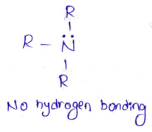
Aliphatic amines are stronger bases than aromatic amines because:
Due to resonance in aromatic amines, the lone pair of electrons on the nitrogen atom gets delocalized over the benzene ring and thus is less available for protonation.
The aryl amine ions have lower stability than the corresponding aliphatic amines i.e. protonation of aromatic amines is not favored.
